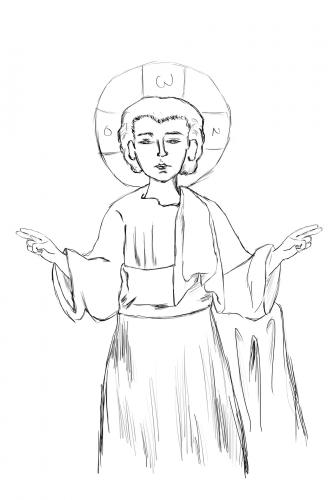



Jesus Emmanuel
The significance of the the names is a reference to Matthew 1:20-23, where in the scene of Annunciation, Archangel Gabriel told the Virgin Mary that she would conceive and give birth to a son whose name will be Iisus (Hebrew Yehoshua, meaning “Saviour”) and Emmanuel (Hebrew Immanuel, meaning “God is with us”). The second name refers to the Messianic verses in Joshua 7:14 ”Behold, a virgin shall conceive, and bear a son, and shall call his name Immanuel”, interpreted, by the Christian Church as announcing the birth of Christ.
The iconography of Iisus Emmanuel presents the character as a beardless youth short-haired and curly, in a frontal posture, dressed in a long tunica with a draped chiton over it. The blessing gesture may imply one hand or both of them. The nimbus cruciger around the head symbolizes Jesus’ sacrifice. Emmanuel represents one of the divine attributes of Jesus and he appears usually in many Biblical themes, especially Eucharistic ones: in frescoes in the altar zone, as icon or illumination, on the diskos itself or in the chalice. Often it is represented within a simple circular medallion.
The significance of the the names is a reference to Matthew 1:20-23, where in the scene of Annunciation, Archangel Gabriel told the Virgin Mary that she would conceive and give birth to a son whose name will be Iisus (Hebrew Yehoshua, meaning “Saviour”) and Emmanuel (Hebrew Immanuel, meaning “God is with us”). The second name refers to the Messianic verses in Joshua 7:14 ”Behold, a virgin shall conceive, and bear a son, and shall call his name Immanuel”, interpreted, by the Christian Church as announcing the birth of Christ.
The iconography of Iisus Emmanuel presents the character as a beardless youth short-haired and curly, in a frontal posture, dressed in a long tunica with a draped chiton over it. The blessing gesture may imply one hand or both of them. The nimbus cruciger around the head symbolizes Jesus’ sacrifice. Emmanuel represents one of the divine attributes of Jesus and he appears usually in many Biblical themes, especially Eucharistic ones: in frescoes in the altar zone, as icon or illumination, on the diskos itself or in the chalice. Often it is represented within a simple circular medallion.




